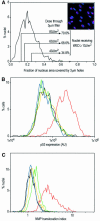Disruption of the nucleolus mediates stabilization of p53 in response to DNA damage and other stresses
- PMID: 14609953
- PMCID: PMC275437
- DOI: 10.1093/emboj/cdg579
Disruption of the nucleolus mediates stabilization of p53 in response to DNA damage and other stresses
Abstract
p53 protects against cancer through its capacity to induce cell cycle arrest or apoptosis under a large variety of cellular stresses. It is not known how such diversity of signals can be integrated by a single molecule. However, the literature reveals that a common denominator in all p53-inducing stresses is nucleolar disruption. We thus postulated that the impairment of nucleolar function might stabilize p53 by preventing its degradation. Using micropore irradiation, we demonstrate that large amounts of nuclear DNA damage fail to stabilize p53 unless the nucleolus is also disrupted. Forcing nucleolar disruption by anti-upstream binding factor (UBF) microinjection (in the absence of DNA damage) also causes p53 stabilization. We propose that the nucleolus is a stress sensor responsible for maintenance of low levels of p53, which are automatically elevated as soon as nucleolar function is impaired in response to stress. Our model integrates all known p53-inducing agents and also explains cell cycle-related variations in p53 levels which correlate with established phases of nucleolar assembly/disassembly through the cell cycle.
Figures







References
-
- Abrahams P.J. et al. (1998) Impaired DNA repair capacity in skin fibroblasts from various hereditary cancer-prone syndromes. Mutat. Res., 407, 189–201. - PubMed
-
- Andersen J.S., Lyon,C.E., Fox,A.H., Leung,A.K., Lam,Y.W., Steen,H., Mann,M. and Lamond,A.I. (2002) Directed proteomic analysis of the human nucleolus. Curr. Biol., 12, 1–11. - PubMed
-
- Blattner C., Tobiasch,E., Litfen,M., Rahmsdorf,H.J. and Herrlich,P. (1999) DNA damage induced p53 stabilization: no indication for an involvement of p53 phosphorylation. Oncogene, 18, 1723–1732. - PubMed
-
- Blaydes J.P., Gire,V., Rowson,J.M. and Wynford-Thomas,D. (1997) Tolerance of high levels of wild-type p53 in transformed epithelial cells dependent on auto-regulation by mdm-2. Oncogene, 14, 1859–1868. - PubMed
Publication types
MeSH terms
Substances
LinkOut - more resources
Full Text Sources
Other Literature Sources
Research Materials
Miscellaneous

